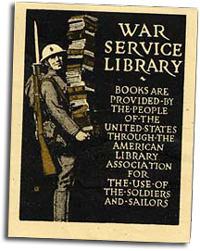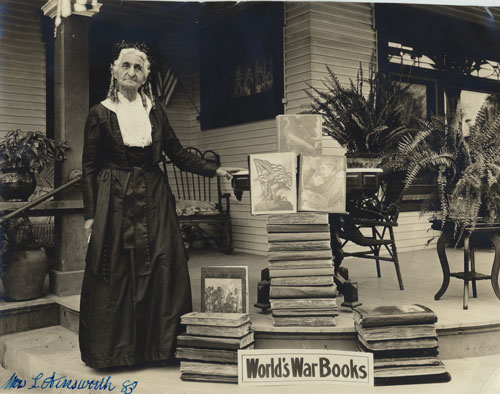"Keener, Better Soldiers"
 The American Library Association mobilized during the war to help create, stock, and staff war service libraries. (OSA, Oregon Defense Council Records, Publications and Ephemera, Box 8, Folder 2)
The American Library Association mobilized during the war to help create, stock, and staff war service libraries. (OSA, Oregon Defense Council Records, Publications and Ephemera, Box 8, Folder 2)
Drives for both books and the money to buy them began just after the American entry into World War I. The government recognized the boost to morale books could provide and asked the American Library Association for help. Once again a national and state structure followed, headed by the national War Library Council.
Among the aims was the initial goal of raising one million dollars to provide libraries and books for cantonments, training camps, posts, forts, naval stations, ships and overseas facilities. The money would buy about 350,000 books that could be rushed to various camps to make the men "more efficient, keener, better soldiers." The reverse side of the argument was that the establishment of the libraries "will reduce drinking, gambling, and kindred vices to a minimum...."
Portland in the Forefront
The Portland Public Library figured prominently in the effort as Northwest headquarters for distribution. The process started modestly with small collections sent to men serving as guards at bridges, tunnels, and docks throughout the state. The library built wooden cases with shelves that served double duty as shipping crates and, once in the camp, served as book cases. Each case held about 60 books. By July the library had sent 1,000 books to the Vancouver Barracks and another site. Over time, many of the books distributed by the library would make their way to the thousands of men toiling in the forests and mills of the Northwest as part of the Army's Spruce Production Division.
Canvassing for Dollars
The work picked up steam in September as the first big War Library Fund drive kicked off. The Portland library took part in the national campaign and set about collecting subscriptions toward the one million dollar national goal. Branch librarians were responsible for their territory within the city and approached the challenge in different ways. Some canvassed door to door while others gathered subscriptions at motion picture shows and similar entertainment venues. One had a "'jitney'" dance in a school house.
The range of attitudes reported by canvassers varied widely and many people needed to be convinced of the importance of providing books for those in service:
As with the other forms of canvassing, workers for the library fund got their "marching orders" with instructions such as:
Of Quotas and Competition
Playing the quota game figured into the library drives from the national offices on down to the district workers. The national headquarters of the War Library Campaign originally set the Oregon quota at $40,000. State leaders reacted that "this amount was of course far too high," and negotiated a reduction to $8,000. The state headquarters then set quotas for each county and district and, to keep the pressure on the district captains and workers, upped the ante: "Endeavor, if possible to double your quota." In spite of the challenges, the campaign proved to be a rousing success. Oregon workers did, indeed, double their quota by bringing in over $19,000. And, by one account, the national goal was exceeded by $700,000.
 An 83-year-old woman stands next to stacks of books to be donated to the book drive. Books about war were particularly popular with the men in the service. (OSA, Oregon Defense Council Records, World War I Photographs, Box 2)
An 83-year-old woman stands next to stacks of books to be donated to the book drive. Books about war were particularly popular with the men in the service. (OSA, Oregon Defense Council Records, World War I Photographs, Box 2)
While patriotism and "doing your bit" for the cause were foremost in the minds of volunteers, competition also figured into the library book drives. In fact, competition played a role in just about every form of war service from the Red Cross sewing work rooms to the liberty loan campaigns. It thrived between states, between counties, between neighboring towns, and between the two women sewing next to each other. This "healthy" competition found eager participants in schools where, Portland for example, saw "Lincoln high school leading with a total of 5,566 [donated] books, and Jefferson second with a total of 3,651 books." And, in the library fund drive, the small community of Antelope in Wasco County "saw it as a matter of local pride" that it gave a larger proportion per capita than "any other town in the United States."
"Have You a Book to Donate?"
As in the Portland schools, solicitations were made throughout Oregon for donated books and magazines. Books that fit the war library circulation needs were distributed to camps. Unwanted materials were sold to second hand dealers or as scrap paper with the proceeds then used to buy more books. According to one appeal for donated books, "the boys" wanted novels, tales of adventure, detective stories and other fiction books. Other popular books focused on engineering, the trades, business, military subjects, foreign languages, travel, history, and biography. However, some books were not appreciated:
Generally, the potential donor was admonished to "not send the books that you would like to get rid of, but those that you would like to keep." As the end of the war drew near, the requests from the military camps for books changed: "Already the boys are coming to the various Y.M.C.A. centers and asking for books on farming, and other things which will help to reestablish them in the world to which they are returning."
Notes
(Oregon State Defense Council Records, State Historian's Correspondence, Box 1, Folder 4)